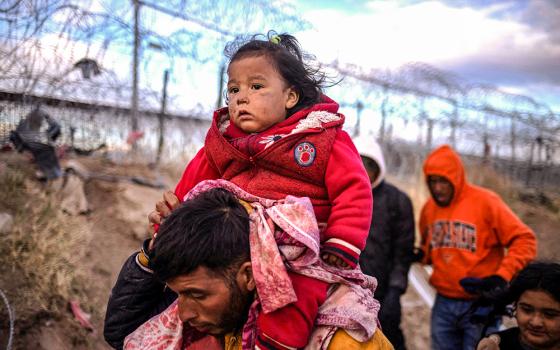LATINO CATHOLICISM: TRANSFORMATION IN AMERICA’S LARGEST CHURCH
By Timothy Matovina
Published by Princeton University Press, $29.95
The future is in the numbers. Census data and recent surveys project a continued, dramatic growth of the U.S. Latino population, fueled by immigration and higher birth rates than other demographic groups, against a declining population of white Americans of European descent. This trajectory has special implications for the U.S. Catholic church, which is now approaching 40 percent Latino membership. Notably, half of all Catholics under age 25 are Latino. Since 1960, Latino Catholics have accounted for 70 percent of all growth among U.S. Catholics. Without this surge, the U.S. Catholic church, which has also seen a major exodus of Euro-Catholic members, would be posting a decline similar to many mainline Protestant churches.
What does it all mean? Timothy Matovina’s new book, Latino Catholicism, offers a comprehensive look at how the numbers are driving a process of transformation within America’s largest church. Matovina, a professor of theology and the director of the Cushwa Center for the Study of American Catholicism at the University of Notre Dame in Indiana, draws on current population data, surveys, history and multidisciplinary research to create a rich narrative of Latino Catholicism from the Spanish conquest to today’s projections for a potentially seismic shift in both the national and religious identity of the United States.
 The book is an essential tool for pastoral planners at every level in the church, for anyone engaged in the debate over immigration reform, for parish ministers facing the complex challenge of multicultural integration as it impacts human services, liturgy and faith formation. It is also a valuable guide for anyone seeking a better understanding of the political and religious implications of the changing face of America and its democratic institutions.
The book is an essential tool for pastoral planners at every level in the church, for anyone engaged in the debate over immigration reform, for parish ministers facing the complex challenge of multicultural integration as it impacts human services, liturgy and faith formation. It is also a valuable guide for anyone seeking a better understanding of the political and religious implications of the changing face of America and its democratic institutions.
Matovina begins with an important history lesson. The first English settlers in the New World landed 120 years after the arrival of Spanish Catholics in the Caribbean and well after the Spanish had conquered Mexico and extended northward into the southeastern and southwestern regions of what would become the continental United States.
Yet American history taught in most schools assumed Anglo-Protestant dominance as the country expanded westward, displacing native peoples and seizing the northern half of Mexico in the 1850s, regarded as an inevitable expression of “Manifest Destiny.” Changing borders made Latino Catholics, established in these territories for 250 years, foreigners in their own land. As millions of immigrants arriving from Europe flooded into the Southwest, Mexican-American citizens were exploited and discriminated against. The racist suppression of Latino culture and religion continued well into the 20th century, with protracted legal battles needed to secure voting rights and equal access to education and public accommodations. Even within the Catholic church, ethnic power politics determined hierarchical appointments, creating a legacy of exclusion for Hispanics seeking recognition within their own church.
Matovina notes that in 1970, Latinos were 26 percent of the church but were represented by only 1 percent of its bishops, while Irish Catholics at 16 percent had 56 percent of bishops. Today, bishops of Latino descent are still only 10 percent of 300 U.S. bishops, in part due to the failure of the church to attract Latino vocations to the priesthood, the only pool for appointment to the hierarchy.
Matovina’s chapter on the state of Latino leadership in the church provides a fascinating but often discouraging look at the rise and fall of Latino influence at the national level from strong post-Vatican II support for Latino ministry to more recent setbacks in the crisis-ridden, financially-strapped U.S. church. In 1972, Latino leaders began a series of five national conferences called Encuentros, whose purpose was to produce a national pastoral plan for Latino ministry. The meetings elicited public commitments from the national conference of bishops to address the special needs of the growing Latino Catholic population. In 1984, the bishops’ conference formed a national Secretariat for Hispanic Affairs, giving voice and resources to support a more effective response to Latino needs.
But in 2006, a major reorganization of the conference reduced the secretariat to a subcommittee of a new umbrella, Cultural Diversity in the Church, cutting staff and funding overall. Latino advocates noted that the national pastoral plan had gone unfunded and also that these new cuts coincided with major payouts in the clergy sex abuse crisis, a blow to the Hispanic community, with its strong family values, and a lost opportunity to increase ministry when it really mattered.
Matovina addresses the complexities of incorporating new immigrants into the church while promoting unity. This includes the debate over whether “national parishes” that preserve language, culture and devotional practices postpone integration or are a necessary stage in moving new groups into the broader, multicultural church. Catholics of Mexican, Puerto Rican and Cuban descent, like earlier German, Irish, Italian and Polish immigrants, have long defended their national parishes. It is likely that future inculturation will include a range of options, from parishes representing a single culture, to dual-culture or multicultural territorial parishes, as immigrant groups enter mainstream American Catholicism.
Another tension affecting Latino entry into the American and Catholic mainstream is the question of whether assimilation into the dominant culture is always a desired goal, since “Americanization,” evident over several generations, often results in loss of traditional culture and religious identity. Preserving Catholic values and beliefs supports gradual integration for Latinos within ethnic enclaves while they achieve economic and educational gains that put them on an even footing with other American groups.
Once heavily concentrated in the Southwest (Mexican), South Florida (Cuban) and New York (Puerto Rican and Dominican), many Latinos, especially new immigrants, are now spreading across the country, going anywhere jobs are available and often creating new Latino majorities within older pockets of Catholics in the traditionally Protestant Midwest and South. The presence of undocumented immigrants is challenging Catholic congregations that were once immigrant, but are now established, to welcome newcomers in need of controversial advocacy and basic material support. The fate of church-supported immigration reform this year may depend on how successful the bishops and local pastors are in promoting multicultural Catholic unity over nativist fear and division.
While Matovina does not shrink from controversial questions or unknowns in his assessment of Latino Catholicism, he remains upbeat about the future and the contributions Latinos have to offer the church and nation. A history of resisting injustice and discrimination has deepened Latinos’ spiritual, liturgical and communal identity as Catholics. Strong lay participation in ministry, and movements like Cursillo, Charismatic Renewal, the growth of small Christian communities in parishes, an emphasis on care for the poor and a history of leadership by women are only some of the gifts Latinos bring to the larger church.
Ready or not, the Catholic church in the United States for decades to come will increasingly reflect its Latino members and the dynamic transformation now under way.
[Pat Marrin is editor of Celebration, NCR’s worship resource. Contact him at pmarrin@ncronline.org. Visit celebrationpublications.org/conference to learn about “Eucharist Without Borders,” Celebration’s April 11-13, 2012, conference in Rio Rico, Ariz., on the role of the church in immigration reform.]




